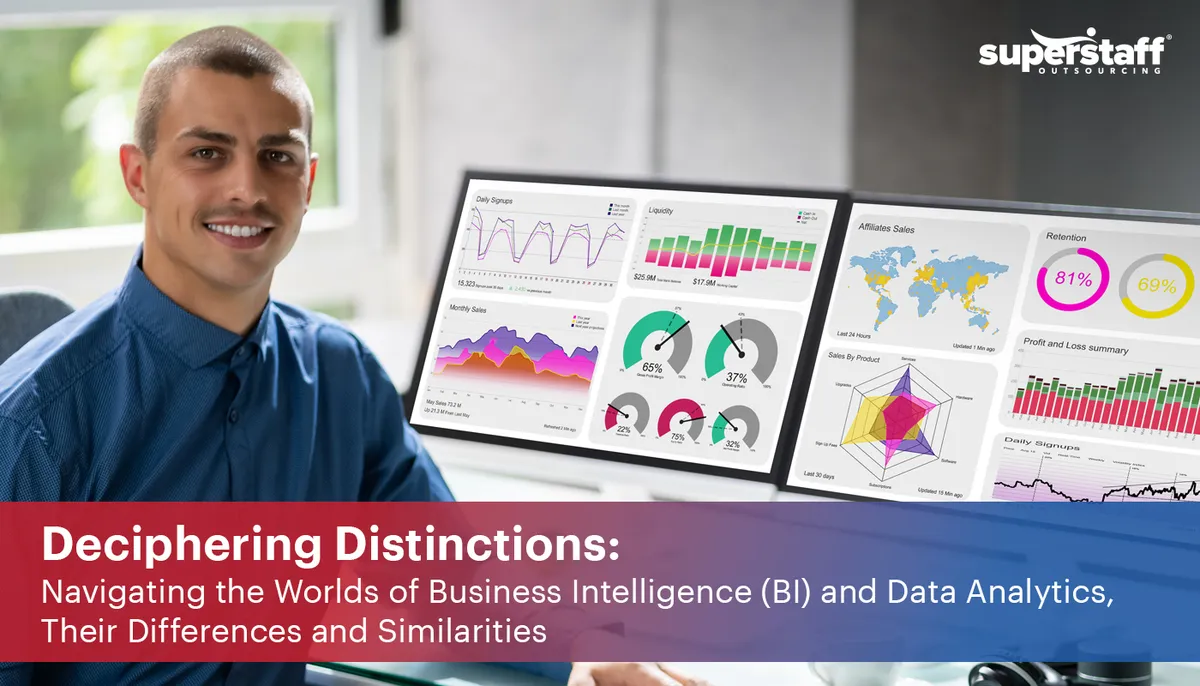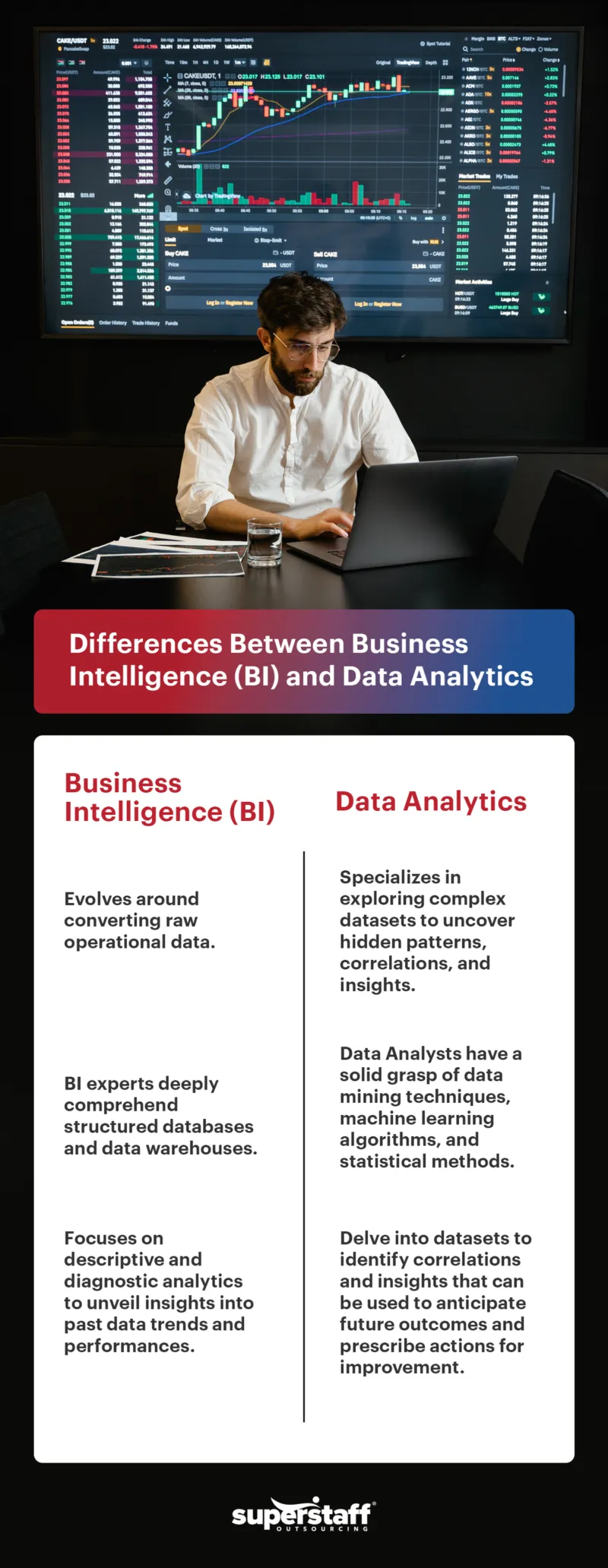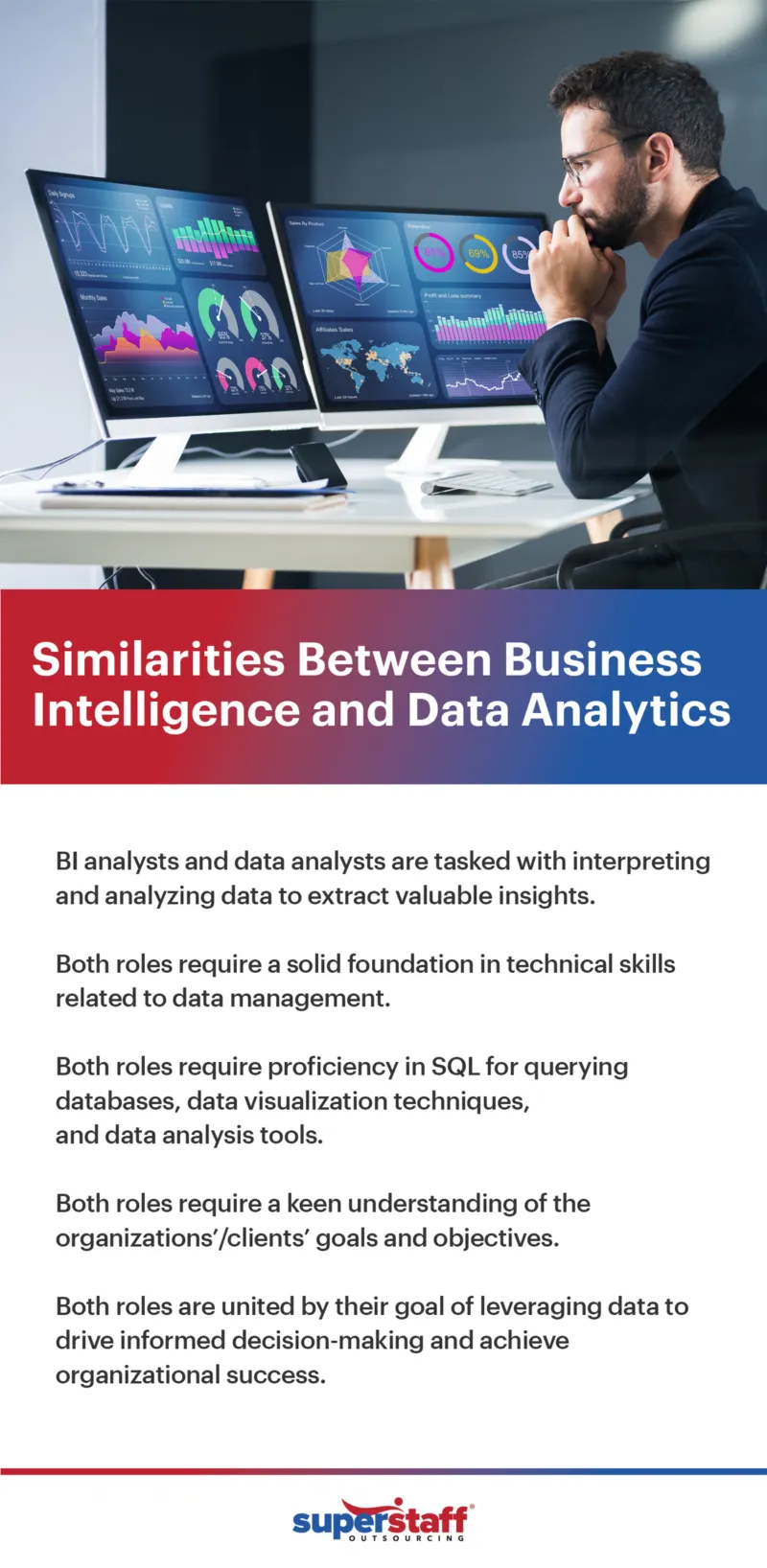
In every industry, from finance to healthcare, from manufacturing to entertainment, data is being collected, analyzed, and utilized at an unprecedented scale. The insights gleaned from this wealth of information revolutionize how businesses operate, enabling them to optimize processes, personalize customer experiences, and anticipate market trends with unparalleled accuracy.
McKinsey has proven this with research showing that businesses that leverage customer data outperform their competition by a whopping 85% in revenue growth and more than 25% in gross margin. The two key pillars in this endeavor are data analytics and business intelligence (BI). While these terms are often used interchangeably, they represent distinct yet complementary aspects of data utilization.
In this blog, we’ll delve into the nuances of data analytics and BI, exploring how they differ and work together to empower organizations.
What Is Business Intelligence?
Business Intelligence (BI) involves converting raw operational data, especially financial data, into user-friendly dashboards and reports, focusing on areas like business workflows and finance.
They require deep knowledge of databases and SQL queries to extract insights. They often employ descriptive and diagnostic analytics to uncover past trends and performance, aiding decision-making and strategy refinement.
The BI global market, valued at $29.42 billion in 2023, is expected to balloon to $54.27 billion by 2023, a testament to the immense potential of the industry.
What is Data Analytics?
Data Analytics explores diverse datasets to uncover insights aligned with business goals. Unlike Business Intelligence, it deals with structured and unstructured data from various sources, employing advanced techniques like data mining and machine learning to extract actionable insights and predict future trends. By focusing on predictive and prescriptive analytics, data analytics enables organizations to make informed decisions and optimize outcomes for the future.
It is a critical industry projected to be worth over $300 billion by 2030.
How Does Data Analytics Differ from Business Intelligence?
Distinguishing between data analytics and business intelligence empowers organizations to align their strategies with their data goals. Understanding the synergy between these disciplines allows businesses to unearth fresh opportunities, mitigate risks, and foster sustainable growth in an increasingly data-driven landscape.

Responsibilities
Business Intelligence (BI) revolves around converting raw operational data, particularly financial data, into comprehensible financial dashboards and reports. BI professionals collaborate closely with business users and subject matter experts to comprehend the organization’s specific needs and objectives.
They then craft visually appealing graphs, charts, spreadsheets, and dashboards to present data in a user-friendly format, enabling stakeholders to interpret and analyze the information quickly. Typically, BI focuses on business workflows, finance, and accounting, aiming to provide insights into operational efficiency, financial performance, and compliance.
On the other hand, Data Analytics specializes in exploring complex datasets to uncover hidden patterns, correlations, and insights. Data analysts often start with broad business goals outlined by leadership and delve into the data to identify relevant patterns and insights contributing to achieving these objectives.
Unlike BI, which primarily deals with structured data, data analysts work with diverse data types and sources, including structured and unstructured data from various channels such as sales transaction logs, emails, customer chat logs, and social media interactions. Data analytics employs advanced techniques such as data mining, machine learning, statistical analysis, and data manipulation to extract actionable insights.
These techniques help uncover valuable information and predict future trends, addressing specific business challenges or opportunities faced by different groups within the organization.
Skills Required
Business Intelligence (BI) experts deeply comprehend structured databases and data warehouses. They are adept at crafting complex SQL queries and executing intricate joins across tables to extract relevant insights from vast datasets.
Proficiency in data presentation tools and basic user experience design is essential for effectively communicating findings to stakeholders. Commonly used tools in BI include Excel spreadsheets for data manipulation, SQL queries for database querying, and BI platforms like Power BI, Tableau, and Looker for data visualization and analysis.
In the evolving realm of Business Intelligence (BI), having access to structured and dynamic training resources can be transformative. Programs like power bi online training help individuals master the essentials without prior experience.
Data Analytics, meanwhile, demands a solid grasp of data mining techniques, machine learning algorithms, and statistical methods to uncover meaningful patterns and insights within datasets. Professionals in this field should be familiar with data wrangling tools for merging diverse datasets and cleansing data to ensure accuracy and consistency.
Understanding the origin and applicability of different datasets is crucial for identifying relevant sources for analysis. Commonly used tools in data analytics typically include programming languages such as R and Python for statistical analysis, as well as specialized software like SAS and KNIME for data manipulation and modeling.
Focus
Business Intelligence (BI) focuses on descriptive and diagnostic analytics to unveil insights into past data trends and performances. BI professionals leverage tools to translate historical data into easily digestible formats such as charts, diagrams, or numerical representations. By analyzing past data, BI helps organizations understand what happened and why, providing valuable insights for decision-making and strategy refinement.
Data Analytics shifts its focus toward exploring data to uncover patterns and trends that can inform predictive and prescriptive analytics. Data analysts delve into datasets to identify correlations and insights that can be used to anticipate future outcomes and prescribe actions for improvement. By leveraging advanced analytical techniques and tools, such as machine learning algorithms and statistical modeling, data analytics empowers organizations to make data-driven decisions and optimize outcomes in the future.
How Do Data Analytics and Business Intelligence Complement Each Other?

While they may have distinct responsibilities and areas of focus, notable similarities underscore their shared mission of harnessing data to drive organizational success. Let’s dive into the common ground between these two roles.
Data Interpretation
BI analysts and data analysts interpret and analyze data to extract valuable insights. Whether they’re understanding past trends (BI) or identifying predictive patterns (Data Analytics), both roles are crucial in informing strategic decisions within an organization.
Technical Skills
Both roles require a solid foundation in technical skills related to data management. Proficiency in SQL for querying databases, knowledge of data visualization techniques, and familiarity with data analysis tools and platforms are essential for BI analysts and data analysts alike.
Statistical Knowledge
While BI analysts may focus more on descriptive and diagnostic analytics, and data analysts delve into predictive and prescriptive analytics, both roles necessitate a fundamental understanding of statistics. This knowledge enables analysts to make sense of data patterns and trends, guiding decision-making processes.
Data Visualization
Effective data visualization is critical to both BI and Data Analytics. Whether creating financial dashboards (BI analysts) or crafting visualizations of data patterns (data analysts), the ability to present data clearly and understandably is essential for conveying insights to stakeholders.
Business Understanding
While BI analysts typically collaborate closely with business users and subject matter experts to understand business requirements, data analysts also need to grasp the context of the data they analyze and its implications for the business. Both roles require a keen understanding of the organization’s goals and objectives.
Continuous Learning
Given the rapid evolution of data analytics and technology, BI analysts and data analysts must continuously learn. Staying updated on new tools, techniques, and best practices is crucial for remaining effective in their roles and driving innovation within the organization.
They may have distinct roles and focuses, but BI and data analytics share common ground in their approach to working with data. Both roles are united by their goal of leveraging data to drive informed decision-making and achieve organizational success in today’s data-driven world.
Advantages of Outsourcing Data Analytics and Business Intelligence
Outsourcing data analytics has become increasingly popular among businesses seeking to harness the power of data without the need for in-house expertise or infrastructure. Here are some advantages of outsourcing data analytics.
Access to Specialized Expertise
Due to the complex nature of handling and interpreting data effectively, achieving accuracy in business intelligence (BI) and data analytics warrants specialized expertise.
For one thing, both BI and data analytics rely on advanced tools and technologies to process, analyze, and visualize data. Whether using platforms like Tableau or implementing machine learning algorithms for predictive analytics, specialized expertise enables professionals to harness the full potential of available technologies.
One of the key challenges in building an in-house data analytics team is the lack of this expertise. With the demand far exceeding the supply, there was fierce competition among organizations to attract and retain top talent. This competition drove up wages and required significant investment in employee retention strategies.
Fortunately, outsourcing can circumvent this challenge and provide businesses access to a team of specialized professionals with expertise in data science, statistics, machine learning, and other analytical techniques. Providers typically serve diverse clients across industries, exposing them to various methodologies and best practices tailored to each client’s unique needs and challenges.
Cost Savings
As economic uncertainties fuel competition, more businesses increasingly outsource data analytics as a savvy cost-saving strategy.
Outsourcing eliminates the need for salaries, benefits, and overhead costs for maintaining an in-house team. Whether ad-hoc analysis or ongoing support, this strategy allows businesses to pay only for the needed services, optimizing resource allocation.
Savings are manifold and extend beyond immediate benefits. Outsourcing significantly cuts down hardware and software costs. In the long term, the most significant savings stem from not having to maintain a whole team of data scientists on payroll and the associated expenses of hiring, reskilling, and retaining staff.
Ultimately, outsourcing empowers businesses to maximize cost efficiency and allocate resources strategically. They can benefit from reduced overhead costs, streamlined operations, and access to specialized expertise while enhancing their position in the marketplace.
Faster Time to Insights
Time management is critical for any business.
In today’s fast-paced environment, businesses are constantly vying for consumer attention and market share. Time is the decisive factor between launching a product or service ahead of competitors or lagging. Faster time-to-market enables businesses to capitalize on emerging opportunities, respond to market trends, and stay ahead of the curve.
This is why outsourcing is a strategic game-changer. While navigating data analytics can be uncharted territory for some businesses, it is day-to-day operations for experienced providers. Unlike building an in-house team, which means setting up the infrastructure and investing time in onboarding and training, outsourcing allows businesses to tap into existing expertise without delay.
Providers also come equipped with the tools, technologies, and methodologies necessary to swiftly analyze large volumes of data and deliver actionable insights promptly. Leveraging their expertise and resources expedites the process of deriving actionable insights, helping you gain a competitive advantage in today’s fast-paced business environment.
Scalability
The unpredictable nature of data volumes and complexity underscores the importance of scalability in modern businesses. Traditional data analytics approaches often struggle to handle the massive influx of data, leading to performance bottlenecks, resource constraints, and diminished analytical capabilities.
Outsourcing emerges as a strategic solution, offering the flexibility to adapt and expand seamlessly in response to changing data requirements. Whether analyzing historical trends, processing real-time streams, or accommodating future growth, scalable data analytics platforms can effortlessly scale resources to meet evolving demands, ensuring the relevance and applicability of insights across diverse data scenarios.
The ability to scale teams up or down based on client needs is a significant competitive advantage of outsourcing. It’s precious for businesses, such as startups, that require higher levels of adaptability in their operations. Unlike in-house teams, where acquiring talent rapidly or downsizing operations can be challenging, outsourced teams can readily adjust their size to align with evolving requirements.
Focus on Core Competencies
Nowadays, businesses must navigate a complex array of challenges to stay afloat.
Limited budgets, fluctuating demand, and resource constraints pose massive hurdles for businesses of all sizes. Moreover, the proliferation of data, technological advancements, and changing consumer preferences add complexity to resource management, requiring firms to adopt agile and adaptive strategies to stay ahead of the curve.
In response to these challenges, increasingly more businesses prioritize their core competencies — the unique capabilities and strengths that set them apart from competitors. Identifying and nurturing their distinctive strengths empowers enterprises to leverage their unique abilities to create value, drive innovation, and differentiate themselves in the marketplace.
However, limited resources and a thin workforce prevent businesses from concentrating on their strengths. One thing they can do is outsource.
Outsourcing liberates valuable resources, allowing organizations to concentrate on their core activities. Whether a startup, a medium-sized business, or a conglomerate, maintaining a laser focus on core competencies is essential for sustained growth and competitiveness.
Access to Advanced Technologies
Cutting-edge technology is at the core of clean, accurate, and reliable data. Manual data cleansing and validation methods are often labor-intensive and prone to errors, leading to discrepancies and inaccuracies in datasets.
Leveraging advanced technologies automates these processes, improving the preciseness and quality of data. Tech enables businesses to identify and rectify data errors, inconsistencies, and duplicates more efficiently, ensuring that data remains clean, consistent, and fit for purpose.
As such, analytics technologies are crucial for organizations to stay competitive and drive innovation. However, not all businesses have access to them — those who do not can easily leverage outsourcing.
BPO offers a wealth of resources, from predictive modeling and machine learning algorithms to data visualization and dashboarding platforms, enabling organizations to unlock valuable insights and achieve tangible business outcomes. Established providers provide a comprehensive suite of technologies, including industry-leading platforms like Microsoft Power BI, to support the analytical needs of their clients.
Leveraging these tools, outsourcing firms deliver creative and innovative solutions tailored to the unique requirements of each organization, driving actionable insights and facilitating informed decision-making.
Risk Mitigation
In an era marked by evolving regulatory landscapes and heightened cybersecurity threats, mitigating risk is imperative for businesses seeking to safeguard their data assets and maintain compliance. Partnering with reputable outsourcing firms empowers organizations to reduce risks associated with errors, biases, or data breaches.
As regulations and compliance standards evolve and vary across regions, businesses face growing complexities in ensuring adherence to national and international requirements. Providers are well-equipped to navigate these challenges, possessing the expertise and resources to meet regulatory standards and confidently maintain compliance.
Harness the Power of Data Analytics and Business Intelligence With SuperStaff
With the volume of global data generated hitting a staggering 64.2 zettabytes in 2020 alone, businesses must devise forward-looking strategies to harness its potential. This number is projected to over 180 zettabytes balloon in 2025. Are you ready to embrace this data-driven future? Outsourcing can help equip you with the tools and resources you need to keep pace.
SuperStaff offers organizations a strategic advantage in navigating the complexities of modern data-driven environments. With a team of skilled professionals proficient in data mining, statistical analysis, and visualization tools, SuperStaff provides specialized expertise to drive informed decision-making and strategic outcomes.
We also offer maximum scalability and flexibility, allowing organizations to adapt their analytical capabilities to changing business requirements. Whether scaling up for new projects or scaling down during periods of low demand, SuperStaff can adjust resources and capacity to align with client needs, optimizing resource utilization and cost-effectiveness in data analytics and BI initiatives.






